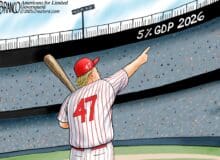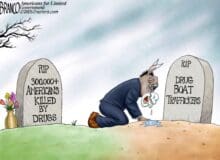(Aug. 31, Hillyer column in special section on faith in T-P/Advocate)
“This is not a ‘dumb rock!’”
Georgetown University chemistry professor Joseph Earley had just dropped a hand-sized pebble, with a clatter, onto the table at the front of the lecture hall, and then held it aloft, while loudly uttering those words.
This class in 1983, called “Scientific Worldview,” was openly described by Earley as “the science course for humanities majors.” Essentially, it was about how science fits in with, informs, and is informed by, other major fields of learning.
Earley’s point with the stone was that very little separated that rock from living organisms. If you could take most of the same chemical elements from that rock but rearrange which protons and which electrons latched on to each other, you could have something alive rather than inert.
Earley went further still: Even assuming the linking of atoms was rearranged to form life, there is nothing in chemistry or physics which yet explains human consciousness. The scientific world that aims to explain the mysteries of the universe runs into that seemingly unsolvable mystery.
Or, as Earley (in one of his many published writings) approvingly quotes from philosopher John R. Searle, “How is it possible in a universe consisting entirely of physical particles in fields of force that there can be such things as consciousness, intentionality, free will, language, society, ethics, [and] aesthetics?”

In Earley’s telling, even the supposedly dumb rock holds the same building blocks that, if rearranged, can lead to life and thence, mysteriously, to human consciousness — but nobody can prove exactly how. Earley, a devout Catholic, therefore posited that science itself leads to the possibility of the inexplicably “unmoved mover.” In sum, perhaps, to God.
From a perch in chemistry, then, Earley joined a long and growing list of scientists who assert that scientific inquiry not only does not contradict God’s existence, but instead makes such existence somewhat more plausible.
While Earley taught, despite so many understandings to the contrary, that the scientific worldview is not at odds with a religious worldview, the broader lesson of his class was that science viewed rightly is in a relational position with all sorts of other fields of inquiry ranging from faith to arts to literature.
What can also be intriguing, however, is the same idea from the other end of the looking glass: from faith to science, or from faith to so many other aspects of our lives….
It is well worth reflecting upon the ways in which faith — in much the same way as Professor Earley’s science — is in relationship with the rest of existence.
One can hope, too, that these explorations will animate what otherwise, physically speaking, is just dumb newsprint… [The full column is at this link.]





